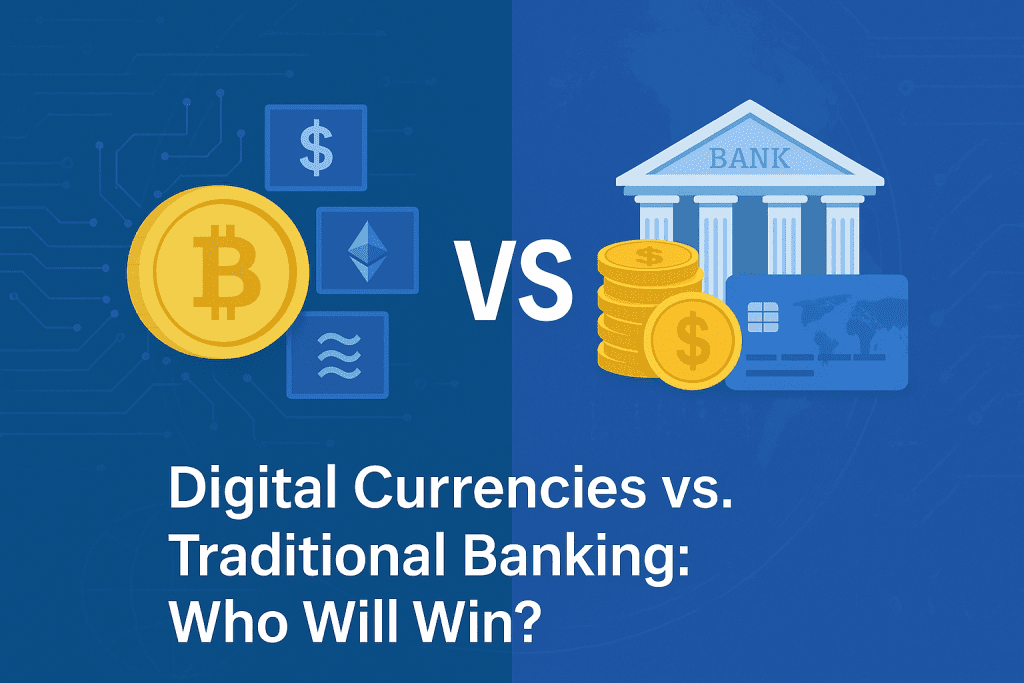Introduction
The world of money is at a pivotal crossroads: digital currenciesare transforming how people move and store value, while traditional banking remains the cornerstone of global finance. With instantly accessible digital wallets and the rise of central bank digital currencies (CBDCs), the competition between digital and conventional banking is fierce. This blog unpacks what digital currency is, how it compares to traditional banking, and which model could shape the future of finance.
What Is a Digital Currency?
Digital currency is a form of money that exists only in electronic form There are no coins or notes. Other names include digital money,
electronic money, e-currency, and cybercast. These currencies are accessible only via computers, smartphones, and online wallets,
and they’re used to execute electronic transactions globally.

Key Take aways
-
Digital currencies are purely electronic; there are no physical coins or notes.
-
They typically allow faster, cheaper transactions by skipping intermediaries.
-
All cryptocurrencies are digital currencies, but not all digital currencies are cryptocurrencies.
-
Pros: Fast transfers, global accessibility, lower costs, enhanced privacy.
-
Cons: Technical barriers, hacking risks, volatile prices, limited acceptance, irreversibility.
Types of Digital Currencies
-
Cryptocurrencies: Decentralized, secured using cryptography, e.g., Bitcoin, Ethereum.
-
Virtual Currencies: Issued by private networks, often for gaming or social platforms.
-
Central Bank Digital Currencies (CBDCs): Regulated, issued by governments (e.g., digital yuan), designed to supplement or replace traditional currency.

Digital Currency vs Traditional Banking
| Feature | Digital Currency | Traditional Banking |
|---|---|---|
| Form | Purely electronic, no physical format | Physical + digital (cash, cards, e-banking) |
| Transaction Speed | Instant, 24/7 global transfers | Slower, especially cross-border, limited by business hours |
| Accessibility | Anyone with an internet connection; global reach | Branch-based, dependent on banking infrastructure |
| Cost | Low transaction fees, no intermediaries | Higher fees, multiple middlemen |
| Regulation | Varies: crypto unregulated, CBDCs highly regulated | Highly regulated and insured |
| Privacy | High (in some types), can be anonymous | Identity-linked, less private |
| Security & Safety | Prone to hacks and irreversibility of errors | Strong consumer protection mechanisms |
| Physical Presence | Not required | Branches for in-person help and complex services |
| Stability & Trust | Volatile (especially crypto); growing for CBDCs | Stable, decades of public trust |
| Use Cases | Remittances, online payments, digital investments | Deposits, loans, wealth management, daily banking |
Where Digital Currencies Shine
-
Seamless online payments and transfers across borders, ideal for gig workers and global businesses.
-
Financial inclusion where traditional banking infrastructure is weak.
-
Programmable money in decentralized finance (Defib), reducing costs and enabling automation (e.g., smart contracts).
-
Increased privacy and control for tech-savvy users.
Where Traditional Banks Reign
-
Widespread acceptability—banks are integrated into most economies.
-
Personal service for complex needs like mortgages, investments, and financial advice.
-
Stability during market upheavals due to regulatory protections.
-
Deposit insurance and consumer protections.
The Future: Competition or Collaboration?
-
Most experts foresee coexistence: digital currencies will complement, not completely replace, traditional banking in the near term.
-
CBDCs are helping banks modernize, allowing for direct, government-backed digital money.
-
Banks are adopting blockchain and digital tech to offer faster payments and enhanced security.
Conclusion
No clear winner has emerged—yet. Digital currencies and traditional banking each serve different needs. Digital currencies are pushing boundaries, making transactions faster, cheaper, and potentially more private. Traditional banks still deliver trust, security, and broad financial services. The ultimate “winner” will likely be a hybrid system, combining digital innovation with the reassuring stability of traditional banks.
Are you ready for the future of money? Explore how digital wallets, crypto, or CBDCs could enhance your financial life—and don’t ignore the staying power of your local bank branch. The choice is increasingly yours!
FAQ
Q1: Are all digital currencies cryptocurrencies?
No, while all cryptocurrencies are digital currencies, not all digital currencies use blockchain or cryptography—CBDCs and virtual currencies are examples that may not.
Q2: Do I need a bank account to use digital currency?
Typically, no. Digital currencies can be accessed via digital wallets without a bank, though some platforms may require identity checks.
Q3: Are digital currencies safer than traditional banking?
Digital currencies offer privacy and fast transfers but carry hacking and volatility risks. Traditional banks provide regulated protection and insurance.
Q4: Can digital currencies replace banks?
Not entirely—banks offer a range of services, personal support, and stability. Digital currencies may complement, but not fully replace, traditional banking soon.
Q5: What is a Central Bank Digital Currency (CBDC)?
A CBDC is a state-issued, regulated digital currency designed to supplement (or eventually replace) physical money, with direct access from central authorities.












